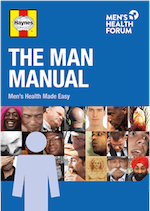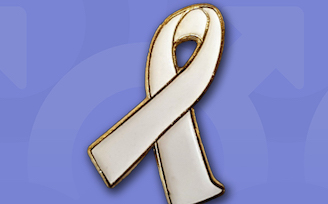Skin Problems FAQs
Acne
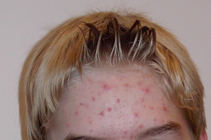
What is it?
Acne causes spots to develop on the skin, usually on the face, back and chest. It is most common in teenagers and young adults.
What causes it?
Acne is caused when tiny holes in the skin, known as hair follicles, become blocked. The hair follicle becomes plugged and bulges outwards causing whiteheads to form or exposes the hair follicle causing blackheads. Bacteria that normally live on the skin can infect these follicles leading to collections of pus.
What is the treatment?
Wash the area with mild soap not more than two times per day. Washing too often can irritate the skin making the symptoms worse. Don't squeeze spots as this can lead to permanent scarring. Most people who develop acne will resolve naturally in time. Some however need treatment;
- topical retinoids - a cream that prevents the production of sebum which leads to spots
- topical antibiotics - another cream that kills the bacteria on your skin to prevent them becoming infected
- benzoyl peroxide - prevent dead skin plugging up hair follicles as well as killing bacteria
Medications take at least three months till you see noticeable effects. There are also stronger medications that may be used if the above fail to make a difference.
Eczema
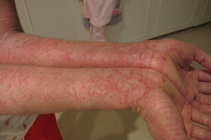
What is it?
Eczema is a condition that causes the skin to become itchy, red, dry and cracked
What causes it?
It is caused by a mixture of inherited and environmental factors. Some people are likely to develop as they have close family members with eczema.
What is the treatment?
There is no cure for eczema but there are things you can do and treatments to ease the symptoms. Try not to scratch your skin as this irritates it and makes it more itchy. Eggs, nuts and milk have been found to make symptoms of eczema worse in some people. Although it may not be healthy to entirely cut these out without medical advice, it may be worth asking your GP for food allergy test.
Your GP can also offer you two forms of treatment
- emoillents - used all the time to alleviate symptoms by keeping skin moist
- topical corticosteroids - used infrequently to tackle flare ups They can reduce inflammation and swelling.
Psoriasis
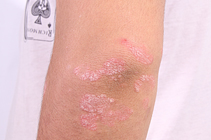
What is it?
A condition that causes flaky, red patches on the skin. They can look shiny and cause itching or burning. They can be anywhere, but are more common on elbows, knees and the lower back.
What causes it?
Some of the body’s antibodies attack skin cells by mistake, causing them to reproduce too quickly and build up on the skin. Certain things may make symptoms worse, including alcohol, smoking and some medicines (such as ibuprofen)
What is the treatment?
There is no cure for psoriasis, but treatment will usually help keep the condition under control. Treatments are determined by the type and severity of your psoriasis and the area of skin affected. Your doctor will probably start with a mild treatment, such as topical creams (which are applied to the skin), and then move on to stronger treatments if necessary.
- topical - creams and ointments that are applied to your skin
- phototherapy - your skin is exposed to certain types of ultraviolet light
- systemic - oral and injected medications that work throughout the entire body
Ringworm
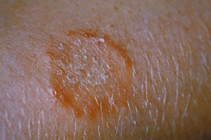
What is it?
Ringworm is not a worm but a number of fungal infections that grow in a patch or circle on the skin. It can be a few millimetres to a few centimetres across. The patches or circles look red or silvery and can blister and ooze.
What causes it?
Fungal spores enter the skin through a break, such as a scratch or a patch of eczema. Ringworm can be passed on through direct contact and sharing items such as towels, bedding or combs. It can also be passed on from the floor of shower or swimming pool areas. Pets can pass it to people.
What is the treatment?
Antifungal creams, powders or tablets, available from the pharmacy, can be effective.
Vitiligo
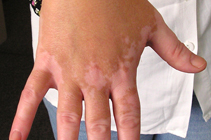
What is it?
Vitiligo causes pale, white patches on the skin. These patches can occur anywhere, but are more noticeable on areas that are exposed to sunlight, such as the face and hands, and on dark or tanned skin. On the scalp, vitiligo can cause hair to turn white. Patches can be small or large, stay the same size or grow. Vitiligo cannot be passed on through close contact.
What causes it?
It is caused by a lack of melanocyte cells, which colour the skin. These cells can be missing because:
- the immune system isn't working properly and attacks them
- the skin has come into contact with certain chemicals or has been severely sunburnt
What is the treatment?
Treatment aims to restore skin colour and control the spread of vitiligo. Treatment can include:
- steroid creams
- ultraviolet A (UVA) light
- disguising the patches with coloured creams, some of which are available on prescription
If vitiligo affects more than 50% of the skin, treatment may involve lightening the healthy skin using prescription creams.
Warts
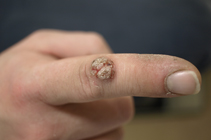
What is it?
Warts are flesh-coloured lumps, which can be 1mm to over 1cm across. Warts can appear anywhere, but usually affect the hands and feet. A wart on the foot is called a verruca. Genital warts appear around the genitals or anus.
What causes it?
They are caused by infection with the human papilloma virus (HPV), which can be passed on through skin-to-skin contact and sometimes through surfaces such as floors and towels. If you have a wart, you can spread it to other people through close contact and also to other parts of your own body.
What is the treatment?
Most warts go away by themselves, but this can take up to two years. Treatments include:
- over-the-counter creams and gels (not for use on genital warts): ask your pharmacist which ones may be suitable for you
- prescription chemicals, to be dabbed onto the wart
- cryotherapy (freezing), which should be carried out by a practitioner who is trained in cryotherapy
We don't currently post comments online but are always keen to hear your feedback.
Photo Credits
- Acne - Wikimedia Commons (Attribution not needed)
- Eczema - Openstax College
- Psoriasis - John D. Peter
- Ringworm - Wikimedia Commons (Attribution not needed)
- Vitiligo - Wikimedia Commons: Produnis
- Warts - John D. Peter
Date published
08/04/14
Date of last review
08/04/14
Date of next review
08/04/17
References
|
The Men’s Health Forum need your support It’s tough for men to ask for help but if you don’t ask when you need it, things generally only get worse. So we’re asking. In the UK, one man in five dies before the age of 65. If we had health policies and services that better reflected the needs of the whole population, it might not be like that. But it is. Policies and services and indeed men have been like this for a long time and they don’t change overnight just because we want them to. It’s true that the UK’s men don’t have it bad compared to some other groups. We’re not asking you to ‘feel sorry’ for men or put them first. We’re talking here about something more complicated, something that falls outside the traditional charity fund-raising model of ‘doing something for those less fortunate than ourselves’. That model raises money but it seldom changes much. We’re talking about changing the way we look at the world. There is nothing inevitable about premature male death. Services accessible to all, a population better informed. These would benefit everyone - rich and poor, young and old, male and female - and that’s what we’re campaigning for. We’re not asking you to look at images of pity, we’re just asking you to look around at the society you live in, at the men you know and at the families with sons, fathers and grandads missing. Here’s our fund-raising page - please chip in if you can. |
